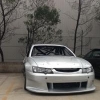Announcements
-
Similar Content
-
Latest Posts
-
Maybe Josh could and should look at that UniClutch thingo too. The street twin one would take the power he's talking about easily. Light action and no noise.
-
By soviet_merlin · Posted
Man, clutch feel is so subjective. I moved to the Nismo Twin from a heavy single plate NPC Heavy Duty Organic and it is sooo much better to drive in everyday traffic. A heavy clutch pedal is the worst here. The Nismo is light enough I don't even think about it. But with the heavy clutch in traffic I was aware of every time I had to push the pedal. In terms of being grabby I would describe it like this: - A normal clutch has ~10cm of clutch pedal travel between initial bite point and clutch fully gripping - With the Nismo twin plate it's ~4cm of clutch pedal travel for the same From what I understand that's normal for multi-plate clutches. Maybe the Nismo is more forgiving than others, don't know. It's not punishing but you have to get used to it. My driving is 80% city and no issues there. Smooth to take off and change gears. Hill starts are mostly fine. It is a bit of a pain for reversing on an incline. I find it hard to get the right amount of clutch slip for that and always end up feeling like I'm burning it too much. But, you may have a very different experience based on your body type and footwear. With heavy boots or shoes it's likely going to be pretty shit. Just because the clutch is light and the boots don't give enough feel to let the clutch pedal out with precision. Might be similar if you are a big guy or have motor control issues. But able-bodied and driving with decent shoes it feels great. You don't mention noise at all. It does chatter at idle RPM when it gets warm. Nothing that is out of place in a GTR though IMO. -
Totally why you should replace your pistons with rotors...
-
By Dose Pipe Sutututu · Posted
put the the house on DOGECOIN lol... (no don't do that).
-







Recommended Posts
Create an account or sign in to comment
You need to be a member in order to leave a comment
Create an account
Sign up for a new account in our community. It's easy!
Register a new accountSign in
Already have an account? Sign in here.
Sign In Now